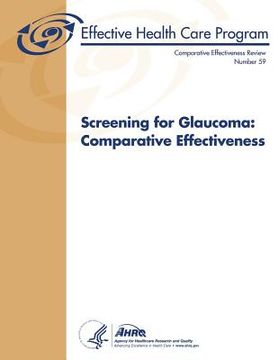Screening for Glaucoma: Comparative Effectiveness: Comparative Effectiveness Review Number 59 (in English)
Synopsis "Screening for Glaucoma: Comparative Effectiveness: Comparative Effectiveness Review Number 59 (in English)"
Glaucoma is a leading cause of visual impairment and blindness and affects approximately 60.5 million people worldwide. Although glaucoma may be characterized by optic nerve damage, visual field loss, and elevated intraocular pressure, there is no consensus definition for confirming diagnosis. Damage is irreversible, so early detection can prevent severe vision loss. Open-angle glaucoma (OAG), the most common subtype of the disease, affects more than 2.5 million people in the United States, with a median age-adjusted prevalence of 4.6 percent among black people and 1.6 percent among white people (based on year 2000 estimates).Unfortunately, it has been shown that only half of the prevalent cases of glaucoma have been identified in the United States due to at least two factors. First, glaucoma is an asymptomatic disease that patients do not notice until the onset of advanced disease, accompanied by severe vision loss. Second, there is no single test to identify people with glaucoma, which has severely hampered the establishment of screening-based programs to detect the disease. The March 2005 U.S. Preventive Services Task Force (USPSTF) recommendation addressing screening for glaucoma stated that there was "insufficient evidence to recommend for or against screening adults for glaucoma." The USPSTF noted that intraocular pressure measurement and optic nerve head assessment alone have limited effectiveness as population based screening tools. The USPSTF also concluded that methods used to assess visual field loss may be impractical for population-based screening due to the length of time required for testing and the challenge of equipment portability. Since 2005, there have been significant advances in the devices used to assess optic nerve structure and function, with several published studies on new diagnostic tests, such as frequency doubling technology, used to assess visual field loss. Because of this new evidence, we believe that a re-evaluation of the safety and effectiveness of population-based glaucoma screening is warranted. The objective of this review was to summarize the evidence regarding the safety and effectiveness of screening-based programs for OAG, with a specific focus on the effects of screening on visual impairment, patient-reported outcomes, intraocular pressure, visual field loss, optic nerve damage, and adverse effects. The effect of screening on these outcomes is considered in the context of treatment of those who, after having been screened, are diagnosed as having glaucoma. This review also includes a summary of the diagnostic accuracy of screening examinations and tests for OAG. Key Questions include: KQ1: KQ1a: Does a screening-based program for open-angle glaucoma lead to less visual impairment when compared with no screening program? KQ1b: How does visual impairment vary when comparing different screening-based programs for open-angle glaucoma? KQ2: KQ2a: Does a screening-based program for open-angle glaucoma lead to improvements in patient-reported outcomes when compared to no screening? KQ2b: How do patient-reported outcomes vary when comparing different screening-based programs for open-angle glaucoma? KQ3: What is the predictive value of screening tests for open-angle glaucoma? KQ4: KQ4a: Does a screening-based program for open-angle glaucoma lead to reductions in intraocular pressure when compared with no screening program? KQ4b: How does intraocular pressure vary when comparing different screening-based programs for open-angle glaucoma? KQ5: KQ5a: Does a screening-based program lead to a slowing of the progression of optic nerve damage and visual field loss when compared with no screening program? KQ5b: How do optic nerve damage and visual field loss vary when comparing different screening-based programs for open-angle glaucoma? KQ6: What are the harms associated with screening for open-angle glaucoma?

